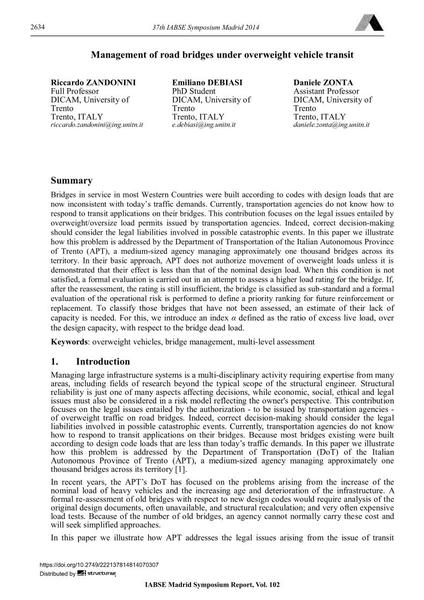Management of road bridges under overweight vehicle transit

|
|
|||||||||||
Détails bibliographiques
| Auteur(s): |
Riccardo Zandonini
Emiliano Debiasi Daniele Zonta |
||||
|---|---|---|---|---|---|
| Médium: | papier de conférence | ||||
| Langue(s): | anglais | ||||
| Conférence: | IABSE Symposium: Engineering for Progress, Nature and People, Madrid, Spain, 3-5 September 2014 | ||||
| Publié dans: | IABSE Symposium Madrid 2014 | ||||
|
|||||
| Page(s): | 2634-2641 | ||||
| Nombre total de pages (du PDF): | 8 | ||||
| Année: | 2014 | ||||
| DOI: | 10.2749/222137814814070307 | ||||
| Abstrait: |
Bridges in service in most Western Countries were built according to codes with design loads that are now inconsistent with today’s traffic demands. Currently, transportation agencies do not know how to respond to transit applications on their bridges. This contribution focuses on the legal issues entailed by overweight/oversize load permits issued by transportation agencies. Indeed, correct decision-making should consider the legal liabilities involved in possible catastrophic events. In this paper we illustrate how this problem is addressed by the Department of Transportation of the Italian Autonomous Province of Trento (APT), a medium-sized agency managing approximately one thousand bridges across its territory. In their basic approach, APT does not authorize movement of overweight loads unless it is demonstrated that their effect is less than that of the nominal design load. When this condition is not satisfied, a formal evaluation is carried out in an attempt to assess a higher load rating for the bridge. If, after the reassessment, the rating is still insufficient, the bridge is classified as sub-standard and a formal evaluation of the operational risk is performed to define a priority ranking for future reinforcement or replacement. To classify those bridges that have not been assessed, an estimate of their lack of capacity is needed. For this, we introduce an indexαdefined as the ratio of excess live load, over the design capacity, with respect to the bridge dead load. |
||||
